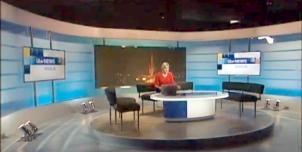Full Freeview on the Tacolneston (Norfolk, England) transmitter
| Google Streetview | Google map | Bing map | Google Earth | 52.518,1.139 or 52°31'6"N 1°8'22"E | NR16 1DW |
The symbol shows the location of the Tacolneston (Norfolk, England) transmitter which serves 330,000 homes. The bright green areas shown where the signal from this transmitter is strong, dark green areas are poorer signals. Those parts shown in yellow may have interference on the same frequency from other masts.
This transmitter has no current reported problems
The BBC and Digital UK report there are no faults or engineering work on the Tacolneston (Norfolk, England) transmitter._______
Digital television services are broadcast on a multiplexes (or Mux) where many stations occupy a single broadcast frequency, as shown below.
64QAM 8K 3/4 27.1Mb/s DVB-T MPEG2
DTG-12 QSPK 8K 3/4 8.0Mb/s DVB-T MPEG2
H/V: aerial position (horizontal or vertical)
Which Freeview channels does the Tacolneston transmitter broadcast?
If you have any kind of Freeview fault, follow this Freeview reset procedure first.Digital television services are broadcast on a multiplexes (or Mux) where many stations occupy a single broadcast frequency, as shown below.
64QAM 8K 3/4 27.1Mb/s DVB-T MPEG2
DTG-12 QSPK 8K 3/4 8.0Mb/s DVB-T MPEG2
H/V: aerial position (horizontal or vertical)
Which BBC and ITV regional news can I watch from the Tacolneston transmitter?

BBC Look East (East) 0.8m homes 3.2%
from Norwich NR2 1BH, 16km northeast (37°)
to BBC East region - 27 masts.
70% of BBC East (East) and BBC East (West) is shared output

ITV Anglia News 0.8m homes 3.2%
from NORWICH NR1 3JG, 16km northeast (38°)
to ITV Anglia (East) region - 26 masts.
All of lunch, weekend and 80% evening news is shared with Anglia (West)
Are there any self-help relays?
| Gt Yarmouth | Transposer | 1 km S town centre | 30 homes |
| Lowestoft (2) | Transposer | Rotterdam Rd | 125 homes |
How will the Tacolneston (Norfolk, England) transmission frequencies change over time?
| 1950s-80s | 1984-97 | 1997-98 | 1998-2011 | 2011-13 | 2013-18 | 2013-17 | 17 Jul 2018 | ||
| VHF | C/D E | C/D E | C/D E | E | E T | W T | W T | ||
| C3 | BBCtvwaves | ||||||||
| C31 | com7 | com7 | |||||||
| C32 | _local | ||||||||
| C37 | com8 | com8 | |||||||
| C39 | +ArqB | +ArqB | ArqB | ||||||
| C40 | BBCA | ||||||||
| C42 | SDN | SDN | SDN | SDN | |||||
| C43 | D3+4 | ||||||||
| C45 | ArqA | ArqA | ArqA | ArqA | |||||
| C46 | BBCB | ||||||||
| C50tv_off | BBCB | BBCB | |||||||
| C52tv_off | C5waves | C5waves | |||||||
| C55tv_off | BBC2waves | BBC2waves | BBC2waves | -BBCA | -BBCA | -BBCA | com7tv_off | ||
| C56tv_off | COM8tv_off | ||||||||
| C57tv_off | LNR | LNR | |||||||
| C59tv_off | ITVwaves | ITVwaves | ITVwaves | -D3+4 | -D3+4 | -D3+4 | |||
| C62 | BBC1waves | BBC1waves | BBC1waves | BBCB | |||||
| C65 | C4waves | C4waves | C4waves |
tv_off Being removed from Freeview (for 5G use) after November 2020 / June 2022 - more
Table shows multiplexes names see this article;
green background for transmission frequencies
Notes: + and - denote 166kHz offset; aerial group are shown as A B C/D E K W T
waves denotes analogue; digital switchover was 9 Nov 11 and 23 Nov 11.
How do the old analogue and currrent digital signal levels compare?
| Analogue 1-4 | 250kW | |
| SDN, ARQA, ARQB, BBCA, D3+4, BBCB | (-4dB) 100kW | |
| com7 | (-9.6dB) 27.4kW | |
| com8 | (-10.2dB) 24kW | |
| Mux 1*, Mux 2*, LNR | (-14dB) 10kW | |
| Mux A*, Mux B*, Mux C*, Mux D* | (-17dB) 5kW | |
| Analogue 5 | (-18dB) 4kW |
Local transmitter maps
Tacolneston Freeview Tacolneston DAB Tacolneston TV region BBC East Anglia (East micro region)Which companies have run the Channel 3 services in the Tacolneston transmitter area
|
|
Tuesday, 25 July 2017
D
david10:27 PM
OK, thanks.
my setup is as follows : Televes DAT45, (NECESSARY before DTTV but in bypass since) on roof feeding into Antiference 4 way distribution amp feeding 3 rooms.
I checked the signal levels and quality on all the TV's and found them to be 9 and 10 respectively apart from the chan 4+1, so today I re-connected the power unit to the aerial and turned the gain on the distribution amp right down to min (don't panic - I AM aware of the issues regarding signal overload) and the signal has come up to 10 along with the quality except for chan 4+1HD which is way better but only about 7/10 signal and 60% quality - again I am aware that quality and BER are more important than signal alone.
Would the aerial group now be un-suitable for Tacolneston I wonder?
ps...off topic but I am not receiving email updates when people reply......
| link to this comment |
D
david10:41 PM
...oh, and I am using high quality double screened + copper foil RG6 cable and high quality full brass plugs with soldered pins throughout - I replaced the whole lot a few years ago :)
| link to this comment |
Wednesday, 26 July 2017
M
MikeB11:20 AM
Peterborough
david: 'No signal' can also occur when you've got too much signal, and having 100% signal would certainly count as that.
However, if the whole mux is 30% below everything else (and its got hr same power output as the others), then thats most likely a problem with a cable, as Mike P said.
But since you turned down the gain, and the quality went up, that sounds like too much signal.
| link to this comment |
MikeB's: mapM's Freeview map terrainM's terrain plot wavesM's frequency data M's Freeview Detailed Coverage
Thursday, 27 July 2017
D
david5:40 PM
not quite.... I added in the aerial booster and THEN turned the gain of the distribution amp down
As I said I am fully aware of possible problems and effects of too much signal - but as it only appears to be affecting a couple of channels on one mux (COM7) I think we can discount that
| link to this comment |
Friday, 28 July 2017
M
MikeB11:16 AM
Peterborough
david: So you added in an aerial booster..and then turned the amp gain down? So thats still boosting the signal....
Still, as you say, your fully aware of the problems of too much signal.
| link to this comment |
MikeB's: mapM's Freeview map terrainM's terrain plot wavesM's frequency data M's Freeview Detailed Coverage
F
fred12:50 PM
david: "Would the aerial ... now be unsuitable for Tacolneston I wonder?"Maybe not ideal for COM7 on UHF 31. See http://satcure.co.uk/tech….htm :"The DAT45 aerial has a maximum gain of around 16 dB ... However, this gain is concentrated in the upper part of the UHF band so this type of aerial is NOT suitable for ... channels at the low end below number 30 ... you might like to consider a different aerial."
| link to this comment |
Tuesday, 1 August 2017
D
david5:22 PM
.......or I might like to wait until com7 disappears next year
| link to this comment |
S
StevensOnln17:33 PM
david: COM7 will be around until 2020, it won't be closing next year. It will be moving to C55, with COM8 moving to C56 after the frequency changes take place on all transmitters that carry these muxes, until mid 2020.
| link to this comment |
C
Christopher Webber10:23 PM
The table above does not show COM7 or COM8 on C55 & C56.
No one answered my previous question as to whether any muxes will be changed to DVB-T2 next year to increase capacity and bring more HD channels.
Some h.264 channels are already being transmitted but they are all 544x576 anamorphic at pathetic 1MB/s avg, is this what we can expect for Freeview in the future?
Ofcom have already stated they are to lift the minimum bit-rates for the main channels.
I guess we will see more channels crammed in at stupid SVCD frame sizes with bit-rates worse than Youtube just so broadcasters can maximize ad-revenues.
It matters not how good your 4K TV's upscaler is, the picture quality is going to look a mess with a 544x576 1MB/s h.264 source
| link to this comment |
S
StevensOnln111:19 PM
Christopher Webber: It has been widely publicised that COM7 and COM8 will be on C55 & C56 forming a single frequency network following the frequency changes at each transmitter that carries them. It is not shown in the table above because the end column shows frequency allocations following the 700MHz clearance at each transmitter, hence COM7 & COM8 not being shown post 700MHz clearance on any transmitter as they will close at completion of the 700MHz clearence in 2020.
There has been no announcement of any further multiplexes changing to DVB-T2 and it would be very unlikely that such a change would be made with as little as 1 years notice. I would speculate that 2020 would be the earliest any further multiplexes would change to DVB-T2 as that will be the point where the additional capacity provided by COM7 and COM8 will be lost.
| link to this comment |
Select more comments
Your comment please!





